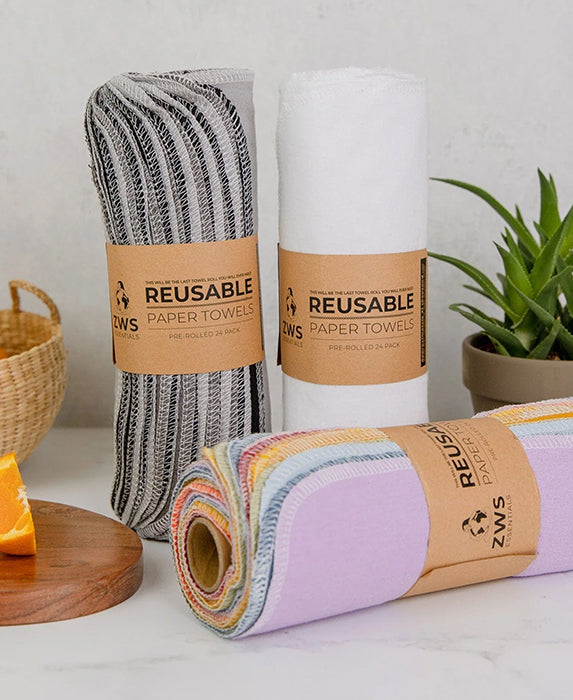10,000 trees planted. Together, that’s what we achieved over the 2019 holiday season, through our partnership with Trees for the Future! From Black Friday to Christmas, for every order placed at EarthHero.com, we donated to Trees for the Future to aid in their forest garden project, helping them plant 10,000 trees throughout the season! Join us as we breakdown the amazing mission of Trees for the Future, how they’re changing the world, and how you can get involved.
What you’ll learn:
- The history and background of the non-profit Trees for the Future
- About the global deforestation problem, and how Trees for the Future supports farmers, and forests
- How EarthHero is teaming up with Trees for the Future to give back this holiday season!
What is Trees for the Future?
 When couple Grace and Dave Deppner decided to volunteer in the Philippines in the early 1970’s, they were astounded by the unsustainable logging practices there that were destroying the natural wildlife and disrupting human living conditions. For the next few years, they spent their time in the Philippines restoring natural ecosystems, rebuilding communities, and learning about the larger deforestation issue.
When couple Grace and Dave Deppner decided to volunteer in the Philippines in the early 1970’s, they were astounded by the unsustainable logging practices there that were destroying the natural wildlife and disrupting human living conditions. For the next few years, they spent their time in the Philippines restoring natural ecosystems, rebuilding communities, and learning about the larger deforestation issue.
After gaining hands-on experience in the ever-changing world of natural resource conservation, Grace and Dave returned to the United States with the goal of creating a public charity dedicated to planting trees, just as they had done in the Philippines. So, in 1989, Trees for the Future was born. Flash forward 30 years and Trees for Future is still fighting to help recover the Earth’s natural ecosystems through planting more than 115 million trees across the world and giving back to the farmers and communities that raise these forests while they do it!
Why plant trees?
Well, simply put, because trees are awesome. They take carbon dioxide (a major greenhouse gas and contributor to climate change!) out of our atmosphere and store, or “sequester,” it, all while releasing fresh oxygen for us to breathe. They create unique ecosystems for other plants and animals, give nutrients to our soil, and combat desertification and soil erosion where they are planted. But, in the last 150 years, humans have begun to impact our natural ecosystems in devastating ways, including causing massive, widespread deforestation.
 According to data collected by Trees for the Future, every single minute 50 soccer fields worth of trees are cut down! That’s 72,000 soccer fields worth of trees every single day. These unsustainable deforestation practices are correlated with forest fires, rising ocean levels, decreased air quality, and increased levels of natural disasters due to losing the protective barrier forests can provide. So, it’s clear something needs to change, but what?
According to data collected by Trees for the Future, every single minute 50 soccer fields worth of trees are cut down! That’s 72,000 soccer fields worth of trees every single day. These unsustainable deforestation practices are correlated with forest fires, rising ocean levels, decreased air quality, and increased levels of natural disasters due to losing the protective barrier forests can provide. So, it’s clear something needs to change, but what?
Although deforestation has happened for decades, in almost every place across the globe, most of the problem right now is occurring in Africa, Latin America, and South America, with many causes and complications. Big corporations are able to more easily purchase land in these countries, with less governmental restrictions on how and when to cut down trees. This leads to unsustainable logging practices, land clearing, and transformation of forests into monoculture agriculture plots or cattle farms.
On the other end, smaller, family-owned farms are often not given the resources or education needed to transition their land towards sustainable, holistic agricultural practices, and instead choose practices that benefit growth and cultivation in the short term – which can often be harmful for the planet and include deforestation or monoculture agriculture. Education, legislation, and time are needed to create a new framework for corporations and communities alike in these countries.
What is a forest garden?

Instead of planting crops in a traditional way, which means rows and rows of one, or a few, types of trees on an empty plot of land, Trees for the Future plants something called forest gardens! Forest gardens create more holistic and regenerative natural habitats; they consist of many different species of trees and plants which help to regenerate the soil, provide sustainable food sources for humans and their livestock, and give families a source of income from the plants they grow. This solution has proven to be successful and scalable, and has huge potential in deforested communities worldwide.
When planting a forest garden, the trees and other crops are planted in a systematic way over the course of four years. From this growth, the surrounding community will reap benefits for generations! In fact, families that have been a part of the forest garden program have seen a 400% increase in their annual income as a result of the money they save growing their own food and selling the rest.
Before forest gardens were conceptualized, the lack of education in these rural farming areas caused a disconnect between the farmers and the land they worked on because they didn’t truly understand how their practices were impacting the planet. Even when farmers are aware of the environmental consequences, they often didn’t have the money or resources to switch to sustainable farming practices. Trees for the Future tackles all these obstacles by training farmers on how to plant their own forest gardens, how to care for them long-term, and showing them ways to use the resources of the forest garden to benefit themselves financially.

They start by identifying farmers who need help and are likely to succeed, and approach them with the project! While farmers are responsible for providing land, water, and labor for their farm, Trees for the Future gives farmers nursery supplies (seeds, fertilizer, etc.), training in forest gardens, and aids them in the process of transitioning their crops over to a more sustainable system over four years. To date, they have helped to create more than 125,000 forest gardens, with the goal of bringing their program to as many farmers in as many countries as possible in order to help end poverty, hunger, and deforestation.
How do forest gardens help our planet?
As the climate crisis worsens, and global populations increase, our agricultural and foresting practices will have to become more efficient and sustainable to meet the needs of our changing planet. While forest gardens may seem like a small scale solution to this problem, the truth is that these sorts of community based farming practices are going to be necessary in order to balance a growing population that needs nutrition and raw resources, while managing deforestation and overconsumption. Below, we’ll dive into the 5 largest ways that these forest gardens create long-lasting positive impact!

1. Food Security
The United Nations Food and Agriculture Organization (FAO) estimates that about 815 million people of the 7.6 billion people in the world, or 10.7%, were suffering from chronic undernourishment in 2016, and almost all the hungry people live in lower-middle-income countries.
Forest gardens combat this by giving communities near them food security, and more nutritious, less-expensive food choices. Conventional farms separate their crops into separate fields and only grown one item per field, limiting the choices for farmers to feed their families with, whereas forest gardens contain as many as 12 crops all grown together. Studies show that while one-crop fields can feed a family for 3-6 months, a forest garden can feed a family for a year. Plus, the biodiversity of the plants grown in a forest garden can protect these crops from viruses and bacteria, reducing the need for pesticides, herbicides, or plant growth additives, and increasing food security as well.
2. Toxic Chemicals
Conventional farming practices require large amounts of harmful pesticides, herbicides, and fertilizers to maximize plant size and growth, while keeping pests and viruses at bay. Sounds great, right? The sad truth is that these chemicals can prevent the soil from reabsorbing nutrients, become soaked into the crops we eat, and make it harder for crops to become naturally pest resistant. Long term studies are beginning to see the impact these chemicals have on those who consume them, and even worse, the workers who work each day on farms with them. Thankfully, forest gardens require no chemicals at all!

Right side: Diet of a family with a Forest Garden
3. Nutrition
When it comes to conventional farming practices, the limited crop selection can cause malnutrition when farmers are relying on their own crops as sustenance, as only a few “profitable” crops will be grown on a single plot of land. Forest gardens provide farmers with far better nutrition because they are growing multiple different types of crops that all yield different nutritional benefits, and can often have livestock integrated in their forest gardens as well, which would require another plot of land on a conventional farm. In addition, the communities they sell their crops to will have many more options to choose from, and increased selections for the farmers to purchase as well.
4. Environment
On average a forest garden can eliminate 62.8 metric tonnes of carbon from the atmosphere per hectare of land, making it an awesome way to reduce increasing carbon emissions on our changing planet! Forest gardens also revitalize the soil with proper nutrients, which improves biodiversity and ultimately causes more tree and crop growth over time. In contrast, conventional farms are actually one of the leading causes of greenhouse gas emissions and soil degradation. Conventional agriculture and livestock production is also the leading cause of deforestation. While a lot is needed to change the way we think about, and consume resources on a global scale, these forest gardens are actively healing some of the most at-risk communities, one tree at a time.
 5. Farmers
5. Farmers
Our favorite part of what Trees for the Future is doing? They’re empowering small farmers, and creating generational change for a future that supports farming communities. Through the forest garden program farmers are able to provide for their families while becoming leaders in the community. They support those in need, and even have an initiative to hire and empower female farmers, shifting the bias created by the conventional farming industry towards male farm owners.
By improving lives and restoring the natural ecosystems, forest garden farmers can spread their knowledge, become self-reliant, and change the culture around sustainability in their community. Conventional input providers just give seeds, fertilizer, and pesticides to the farmers and then end up taking around 60% of profits. This keeps farmers reliant on the broken agricultural system, something Trees for the Future is working to end.
You can see the amazing influence they are having by talking to farmers in their program. One farmer gratefully said, “Before planting trees, I had no money and I had no purpose”, while another shared his experience, “I can get more from my two acre forest garden than I could get from six acres of peanut crops. My sons have a future now, and as I age, trees will continue to feed my family.”
How can I get involved?
From food waste to packaging waste, the holidays are one of the most wasteful times of the year – and our planet is reaching a tipping point. While huge systemic changes will need to be made to shift the way our society consumes, we want to take steps in the right direction by offering ethical products & gifts that support our planet, and the lives of the people who helped make it. But beyond that, we want to help change the world!
This past holiday season, we partnered with Trees for the Future, planting 5 trees for every order. With your help, we were able to plant 10,000 trees, helping the way towards a greener future! Want to get even more involved with this awesome nonprofit? Check out all their ways you can help here.









